Search
- Page Path
- HOME > Search
- [Korean]
- Characterization and Classification of Pores in Metal 3D Printing Materials with X-ray Tomography and Machine Learning
- Eun-Ah Kim, Se-Hun Kwon, Dong-Yeol Yang, Ji-Hun Yu, Kwon-Ill Kim, Hak-Sung Lee
- J Korean Powder Metall Inst. 2021;28(3):208-215. Published online June 1, 2021
- DOI: https://doi.org/10.4150/KPMI.2021.28.3.208
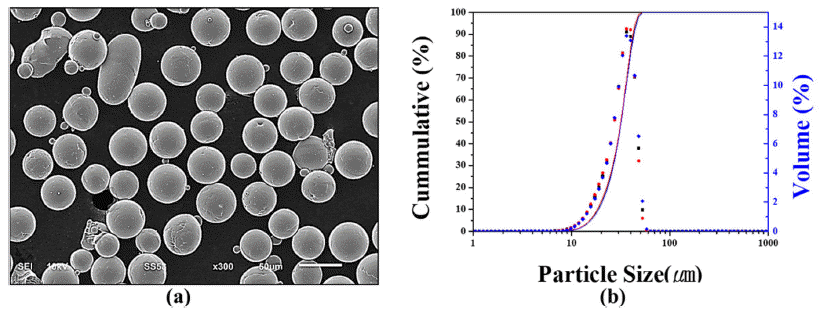
- 738 View
- 13 Download
-
 Abstract
Abstract
 PDF
PDF Metal three-dimensional (3D) printing is an important emerging processing method in powder metallurgy. There are many successful applications of additive manufacturing. However, processing parameters such as laser power and scan speed must be manually optimized despite the development of artificial intelligence. Automatic calibration using information in an additive manufacturing database is desirable. In this study, 15 commercial pure titanium samples are processed under different conditions, and the 3D pore structures are characterized by X-ray tomography. These samples are easily classified into three categories, unmelted, well melted, or overmelted, depending on the laser energy density. Using more than 10,000 projected images for each category, convolutional neural networks are applied, and almost perfect classification of these samples is obtained. This result demonstrates that machine learning methods based on X-ray tomography can be helpful to automatically identify more suitable processing parameters.
- [Korean]
- Spheroidization of Enamel Powders by Radio Frequency Plasma Treatment and Application to Additive Manufacturing
- Ki-Bong Kim, Dong-Yeol Yang, Yong-Jin Kim, Jungho Choe, Ji-Na Kwak, Woo-Hyung Jung
- J Korean Powder Metall Inst. 2020;27(5):388-393. Published online October 1, 2020
- DOI: https://doi.org/10.4150/KPMI.2020.27.5.388

- 605 View
- 3 Download
-
 Abstract
Abstract
 PDF
PDF The enamel powders used traditionally in Korea are produced by a ball-milling process. Because of their irregular shapes, enamel powders exhibit poor flowability. Therefore, polygonal enamel powders are only used for handmade cloisonné crafts. In order to industrialize or automate the process of cloisonné crafts, it is essential to control the size and shape of the powder. In this study, the flowability of the enamel powders was improved using the spheroidization process, which employs the RF plasma treatment. In addition, a simple grid structure and logo were successfully produced using the additive manufacturing process (powder bed fusion), which utilizes spherical enamel powders. The additive manufacturing technology of spherical enamel powders is expected to be widely used in the field of cloisonné crafting in the future.
- [Korean]
- A study about sculpture characteristic of SKD61 tool steel fabricated by selective laser melting(SLM) process
- Jaecheol Yun, Jungho Choe, Ki-Bong Kim, Sangsun Yang, Dong-Yeol Yang, Yong-Jin Kim, Chang-Woo Lee, Chang-Woo Lee
- J Korean Powder Metall Inst. 2018;25(2):137-143. Published online April 1, 2018
- DOI: https://doi.org/10.4150/KPMI.2018.25.2.137
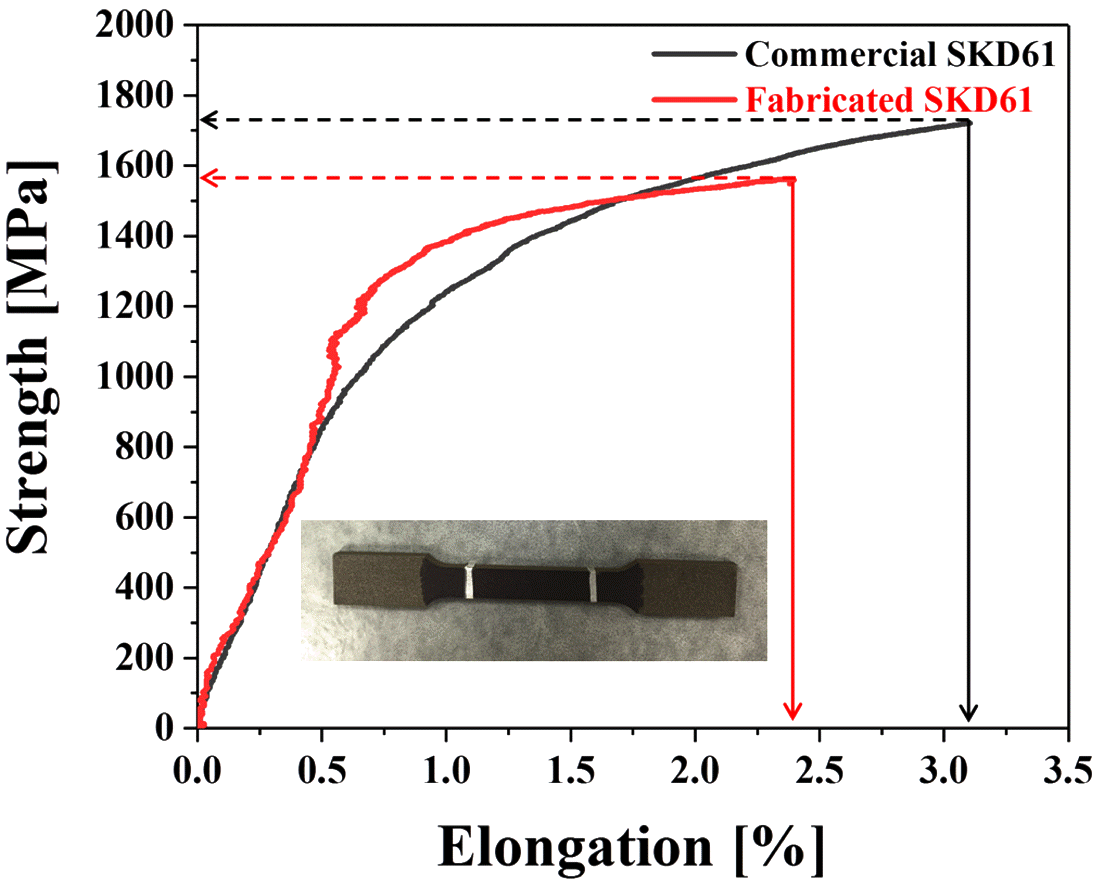
- 896 View
- 3 Download
- 1 Citations
-
 Abstract
Abstract
 PDF
PDF In this study, two types of SKD61 tool-steel samples are built by a selective laser melting (SLM) process using the different laser scan speeds. The characteristics of two kinds of SKD61 tool-steel powders used in the SLM process are evaluated. Commercial SKD61 tool-steel power has a flowability of 16.68 sec/50 g and its Hausner ratio is calculated to be 1.25 by apparent and tapped density. Also, the fabricated SKD61 tool steel powder fabricated by a gas atomization process has a flowability of 21.3 sec/50 g and its Hausner ratio is calculated to be 1.18. Therefore, we confirmed that the two powders used in this study have excellent flowability. Samples are fabricated to measure mechanical properties. The highest densities of the SKD61 tool-steel samples, fabricated under the same conditions, are 7.734 g/cm3 (using commercial SKD61 powder) and 7.652 g/cm3 (using fabricated SKD61 powder), measured with Archimedes method. Hardness is measured by Rockwell hardness testing equipment 5 times and the highest hardnesses of the samples are 54.56 HRC (commercial powder) and 52.62 HRC (fabricated powder). Also, the measured tensile strengths are approximately 1,721 MPa (commercial SKD61 powder) and 1,552 MPa (fabricated SKD61 powder), respectively.
-
Citations
Citations to this article as recorded by- Microstructural effects on the tensile and fracture behavior of selective laser melted H13 tool steel under varying conditions
Jungsub Lee, Jungho Choe, Junhyeok Park, Ji-Hun Yu, Sangshik Kim, Im Doo Jung, Hyokyung Sung
Materials Characterization.2019; 155: 109817. CrossRef
- Microstructural effects on the tensile and fracture behavior of selective laser melted H13 tool steel under varying conditions
- [Korean]
- Investigation on Fe-Hf-B-Nb-P-C Soft Magnetic Powders Prepared by High-Pressure Gas Atomization
- Jae Won Jeong, Dong-Yeol Yang, Ki Bong Kim, Junhong Lee, Young Ja Kim, Tae-Soo Lim, Sangsun Yang, Min Ha Lee, Hwi Jun Kim, Yong-Jin Kim
- J Korean Powder Metall Inst. 2016;23(5):391-396. Published online October 1, 2016
- DOI: https://doi.org/10.4150/KPMI.2016.23.5.391
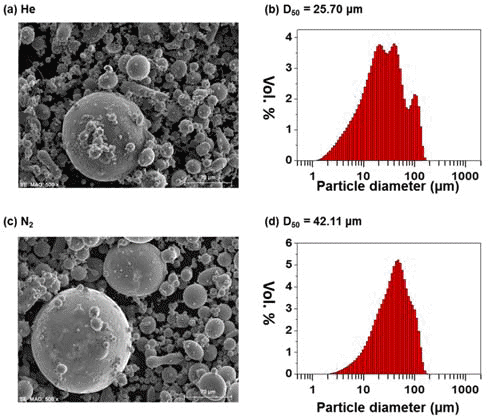
- 651 View
- 1 Download
- 3 Citations
-
 Abstract
Abstract
 PDF
PDF In this study, ultra-fine soft-magnetic micro-powders are prepared by high-pressure gas atomization of an Fe-based alloy, Fe-Hf-B-Nb-P-C. Spherical powders are successfully obtained by disintegration of the alloy melts under high-pressure He or N2 gas. The mean particle diameter of the obtained powders is 25.7 μm and 42.1 μm for He and N2 gas, respectively. Their crystallographic structure is confirmed to be amorphous throughout the interior when the particle diameter is less than 45 μm. The prepared powders show excellent soft magnetic properties with a saturation magnetization of 164.5 emu/g and a coercivity of 9.0 Oe. Finally, a toroidal core is fabricated for measuring the magnetic permeability, and a μr of up to 78.5 is obtained. It is strongly believed that soft magnetic powders prepared by gas atomization will be beneficial in the fabrication of high-performance devices, including inductors and motors.
-
Citations
Citations to this article as recorded by- Optimization of Densification Behavior of a Soft Magnetic Powder by Discrete Element Method and Machine Learning
Jungjoon Kim, Dongchan Min, Suwon Park, Junhyub Jeon, Seok-Jae Lee, Youngkyun Kim, Hwi-Jun Kim, Youngjin Kim, Hyunjoo Choi
MATERIALS TRANSACTIONS.2022; 63(10): 1304. CrossRef - Optimizing the magnetic properties of Fe-based amorphous powder by adjusting atomic structures from vitrification at different temperatures
Song-Yi Kim, Hye-Ryeong Oh, Hyeon-Ah Kim, A-Young Lee, Hwi-Jun Kim, Sang-Sun Yang, Yong-Jin Kim, Hyun-Joo Choi, Il-Hyun Kim, Hyun-Gil Kim, Jürgen Eckert, Jong-Ryoul Kim, Min-Ha Lee
Journal of Applied Physics.2019;[Epub] CrossRef - Soft magnetic properties of Fe-based amorphous/nanocrystalline hybrid materials
Yeonjoo Lee, Jonggyu Jeon, Seungjin Nam, Teasuk Jang, Hwijun Kim, Minwoo Lee, Yongjin Kim, Dongyeol Yang, Kyeongsik Min, Hyunjoo Choi
Powder Technology.2018; 339: 440. CrossRef
- Optimization of Densification Behavior of a Soft Magnetic Powder by Discrete Element Method and Machine Learning
- [Korean]
- Mechanical Property Improvement of the H13 Tool Steel Sculptures Built by Metal 3D Printing Process via Optimum Conditions
- Jaecheol Yun, Jungho Choe, Haengna Lee, Ki-Bong Kim, Sangsun Yang, Dong-Yeol Yang, Yong-Jin Kim, Chang-Woo Lee, Ji-Hun Yu
- J Korean Powder Metall Inst. 2016;24(3):195-201. Published online June 1, 2016
- DOI: https://doi.org/10.4150/KPMI.2017.24.3.195
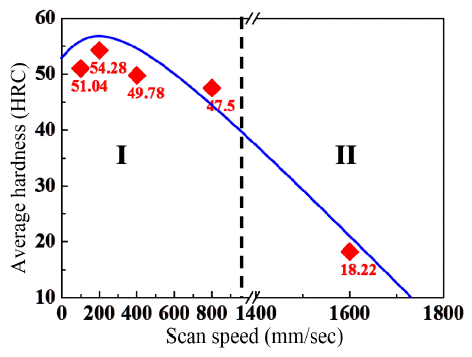
- 1,000 View
- 10 Download
- 7 Citations
-
 Abstract
Abstract
 PDF
PDF In this study, H13 tool steel sculptures are built by a metal 3D printing process at various laser scan speeds. The properties of commercial H13 tool steel powders are confirmed for the metal 3D printing process used: powder bed fusion (PBF), which is a selective laser melting (SLM) process. Commercial H13 powder has an excellent flowability of 16.68 s/50 g with a Hausner ratio of 1.25 and a density of 7.68 g/cm3. The sculptures are built with dimensions of 10 × 10 × 10 mm3 in size using commercial H13 tool steel powder. The density measured by the Archimedes method is 7.64 g/cm3, similar to the powder density of 7.68 g/cm3. The hardness is measured by Rockwell hardness equipment 5 times to obtain a mean value of 54.28 HRC. The optimum process conditions in order to build the sculptures are a laser power of 90 W, a layer thickness of 25 μm, an overlap of 30%, and a laser scan speed of 200 mm/s.
-
Citations
Citations to this article as recorded by- Spheroidization of Enamel Powders by Radio Frequency Plasma Treatment and Application to Additive Manufacturing
Ki-Bong Kim, Dong-Yeol Yang, Yong-Jin Kim, Jungho Choe, Ji-Na Kwak, Woo-Hyung Jung
Journal of Korean Powder Metallurgy Institute.2020; 27(5): 388. CrossRef - Microstructural effects on the tensile and fracture behavior of selective laser melted H13 tool steel under varying conditions
Jungsub Lee, Jungho Choe, Junhyeok Park, Ji-Hun Yu, Sangshik Kim, Im Doo Jung, Hyokyung Sung
Materials Characterization.2019; 155: 109817. CrossRef - Nano-mechanical Behavior of H13 Tool Steel Fabricated by a Selective Laser Melting Method
Van Luong Nguyen, Eun-ah Kim, Jaecheol Yun, Jungho Choe, Dong-yeol Yang, Hak-sung Lee, Chang-woo Lee, Ji-Hun Yu
Metallurgical and Materials Transactions A.2019; 50(2): 523. CrossRef - Correlation between Microstructure and Mechanical Properties of the Additive Manufactured H13 Tool Steel
Woojin An, Junhyeok Park, Jungsub Lee, Jungho Choe, Im Doo Jung, Ji-Hun Yu, Sangshik Kim, Hyokyung Sung
Korean Journal of Materials Research.2018; 28(11): 663. CrossRef - Evaluation of Strain-Rate Sensitivity of Selective Laser Melted H13 Tool Steel Using Nanoindentation Tests
Van Luong Nguyen, Eun-ah Kim, Seok-Rok Lee, Jaecheol Yun, Jungho Choe, Dong-yeol Yang, Hak-sung Lee, Chang-woo Lee, Ji-Hun Yu
Metals.2018; 8(8): 589. CrossRef - Comparison of Nano-Mechanical Behavior between Selective Laser Melted SKD61 and H13 Tool Steels
Jaecheol Yun, Van Luong Nguyen, Jungho Choe, Dong-Yeol Yang, Hak-Sung Lee, Sangsun Yang, Ji-Hun Yu
Metals.2018; 8(12): 1032. CrossRef - A study about sculpture characteristic of SKD61 tool steel fabricated by selective laser melting(SLM) process
Jaecheol Yun, Jungho Choe, Ki-Bong Kim, Sangsun Yang, Dong-Yeol Yang, Yong-Jin Kim, Chang-Woo Lee, Chang-Woo Lee
Journal of Korean Powder Metallurgy Institute.2018; 25(2): 137. CrossRef
- Spheroidization of Enamel Powders by Radio Frequency Plasma Treatment and Application to Additive Manufacturing
- [Korean]
- The Influence of a Single Melt Pool Morphology on Densification Behavior of Three-Dimensional Structure Fabricated by Additive Manufacturing
- Jungho Choe, Jaecheol Yun, Dong-Yeol Yang, Sangsun Yang, Ji-Hun Yu, Chang-Woo Lee, Yong-Jin Kim
- J Korean Powder Metall Inst. 2016;24(3):187-194. Published online June 1, 2016
- DOI: https://doi.org/10.4150/KPMI.2017.24.3.187
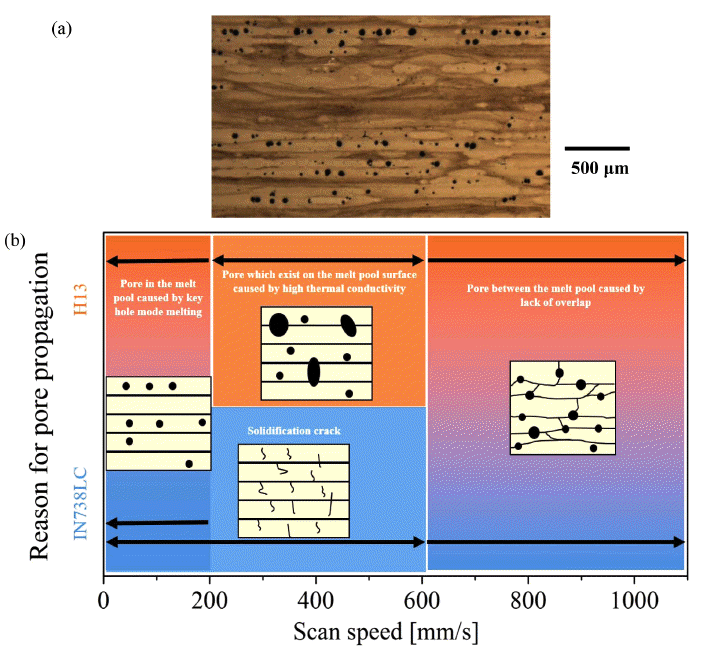
- 713 View
- 2 Download
- 5 Citations
-
 Abstract
Abstract
 PDF
PDF Selective laser melting (SLM) can produce a layer of a metal powder and then fabricate a three-dimensional structure by a layer-by-layer method. Each layer consists of several lines of molten metal. Laser parameters and thermal properties of the materials affect the geometric characteristics of the melt pool such as its height, depth, and width. The geometrical characteristics of the melt pool are determined herein by optical microscopy and three-dimensional bulk structures are fabricated to investigate the relationship between them. Powders of the commercially available Fe-based tool steel AISI H13 and Ni-based superalloy Inconel 738LC are used to investigate the effect of material properties. Only the scan speed is controlled to change the laser parameters. The laser power and hatch space are maintained throughout the study. Laser of a higher energy density is seen to melt a wider and deeper range of powder and substrate; however, it does not correspond with the most highly densified three-dimensional structure. H13 shows the highest density at a laser scan speed of 200 mm/s whereas Inconel 738LC shows the highest density at 600 mm/s.
-
Citations
Citations to this article as recorded by- Microstructural effects on the tensile and fracture behavior of selective laser melted H13 tool steel under varying conditions
Jungsub Lee, Jungho Choe, Junhyeok Park, Ji-Hun Yu, Sangshik Kim, Im Doo Jung, Hyokyung Sung
Materials Characterization.2019; 155: 109817. CrossRef - Correlation between Microstructure and Mechanical Properties of the Additive Manufactured H13 Tool Steel
Woojin An, Junhyeok Park, Jungsub Lee, Jungho Choe, Im Doo Jung, Ji-Hun Yu, Sangshik Kim, Hyokyung Sung
Korean Journal of Materials Research.2018; 28(11): 663. CrossRef - Effect of Porosity on Mechanical Anisotropy of 316L Austenitic Stainless Steel Additively Manufactured by Selective Laser Melting
Jeong Min Park, Jin Myoung Jeon, Jung Gi Kim, Yujin Seong, Sun Hong Park, Hyoung Seop Kim
Journal of Korean Powder Metallurgy Institute.2018; 25(6): 475. CrossRef - Evaluation of the Accuracy of Dental Prostheses manufactured by Metal 3D Printer
Junho Hwang, Yun-Ho Kim, Hyun-Deok Kim, Kyu-Bok Lee
Journal of Welding and Joining.2018; 36(5): 70. CrossRef - A study about sculpture characteristic of SKD61 tool steel fabricated by selective laser melting(SLM) process
Jaecheol Yun, Jungho Choe, Ki-Bong Kim, Sangsun Yang, Dong-Yeol Yang, Yong-Jin Kim, Chang-Woo Lee, Chang-Woo Lee
Journal of Korean Powder Metallurgy Institute.2018; 25(2): 137. CrossRef
- Microstructural effects on the tensile and fracture behavior of selective laser melted H13 tool steel under varying conditions
TOP
 KPMI
KPMI


 First
First Prev
Prev


